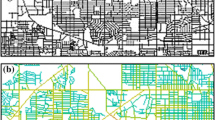Abstract
Definition of city as a complex system opens up to a series of problems that involve the legitimacy of the design of the technocratic plan. The plan nowadays cannot be considered as a black-box tool, but it might be considered as an open process, able to adapt to the needs of citizens and to the socio-economic and environmental contexts. As many scholars underlined, the plan is sequence of phases that must be programmed and that considers the project as a possible scenario, not a definitive one. In a complex and flexible city, the planner (here considered both as the urban studies expert and the political decision maker) has the role to create the conditions for the development of the city, and for creating or maintaining the possibilities of evolution of the citizens who live in a certain territory. In this sense, the strategic aspects of the city plan and its programmatic role, have a relation more with the rules system than with the design one; but it is also very clear that the human space in urban context is made of physically well defined elements. Basing on the most commonly cited example of anti-planning city organization, the MVRDV project Oosterwold, authors underline the importance of the physical and geographical components inside the rules of a plan, nevertheless recognizing the difficulty to establish detailed boundaries to a complex and flexible city.
Access this chapter
Tax calculation will be finalised at checkout
Purchases are for personal use only
Similar content being viewed by others
References
Rabino, G.A.: Processi decision e Territorio nella simulazione multi-agente. Esculapio, Bologna (2005)
Bauman, Z.: Globalizzazione e glocalizzazione. Armando Editore, Roma (2005)
Bauman, Z.: La società dell’incertezza. Il Mulino, Bologna (1999)
Sassen, S.: Making the global economy run: the role of national states and private agents. Int. Soc. Sci. J. 51, 409–416 (1999)
Cesareo, V.: Globalizzazione e contesti locali: Una ricerca sulla realtà italiana. FrancoAngeli Edizioni, Roma (2001)
Horgan, J.: From complexity to perplexity. Sci. Am. 272(6), 104–109 (1995)
Batty, M.: Cities as Complex Systems: Scaling, Interaction, Networks, Dynamics and Urban Morphologies. Encyclopedia of Complexity and Systems Science. Springer, New York (2011)
Sennett, R.: The Corrosion of a Character: the personal Consequences of Work in the New Capitalism, p. 10. W.W. Norton & Company, New York (2000)
Portugali, J.: What makes cities complex? http://www.spatialcomplexity.info. Accessed 22 Oct 2013
Bertuglia, C.S., Staricco, L.: Complessità, autoorganizzazione, città. FrancoAngeli Edizioni, Roma (2000)
Ruelle, D.: Chance and Chaos. Princeton University Press, Princeton (1991)
Gargiulo, C., Papa, R.: Caos e caos: la città come fenomeno complesso. Per il XXI secolo: una enciclopedia e un progetto. Università degli Studi di Napoli Federico II
De Lotto, R.: Il progetto urbanistico nella città flessibile. In: De Lotto, R., Di Tolle, M. (eds.) Elementi di progettazione urbanistica. Rigenerazione urbana nella città contemporanea. Maggioli Editore, Santarcangelo di Romagna (2013)
Moroni, S.: Planning, liberty and the rule of law. Plann. Theory 6(2), 146–163 (2007)
De Lotto, R., Cattaneo, T., Venco, E.M.: Functional reuse and intensification of rural-urban context: rural architectural urbanism. Int. J. Agric. Environ. Inf. Syst. 7(1), 1–27 (2016)
Choay, F.: Del destino della città. Alinea, Milano (2001)
Choay, F.: La città: Utopie e realtà. Einaudi Editore, Torino (1973)
Rauws, W., De Roo, G.: Adaptive planning: generating conditions for urban adaptability, lessons from dutch organic development strategies. Environ. Plann. B Plann. Des. 43(6), 1052–1074 (2016)
MVRDV, Freeland project. https://www.mvrdv.nl/projects/freeland. Accessed 10 Dec 2017
The Why Factory lab. AnarCity Project. http://thewhyfactory.com/output/anarcity/. Accessed 10 Dec 2017
Morelli di Popolo, C.: La città flessibile. Le dimensioni della flessibilità nella città contemporanea e futura. Ph. D. thesis in Civil and Architectural Engineering, XXVI cycle (2014)
Moroni, S.: Rethinking the theory and practice of land-use regulation: towards nomocracy. Plann. Theory 9(2), 137–155 (2010)
Blecic, I., Cecchini, A.: Verso una pianificazione antifragile: Come pensare al futuro senza prevederlo. FrancoAngeli Edizioni, Roma (2016)
Maas, W.: It’s legal, but is it legitimate? Shape Law 38, 106–112 (2014)
Author information
Authors and Affiliations
Corresponding author
Editor information
Editors and Affiliations
Rights and permissions
Copyright information
© 2019 Springer International Publishing AG, part of Springer Nature
About this paper
Cite this paper
De Lotto, R., Morelli di Popolo, C. (2019). The Role of Physical Aspects in the City Plan Rules Definition. In: Calabrò, F., Della Spina, L., Bevilacqua, C. (eds) New Metropolitan Perspectives. ISHT 2018. Smart Innovation, Systems and Technologies, vol 100. Springer, Cham. https://doi.org/10.1007/978-3-319-92099-3_30
Download citation
DOI: https://doi.org/10.1007/978-3-319-92099-3_30
Published:
Publisher Name: Springer, Cham
Print ISBN: 978-3-319-92098-6
Online ISBN: 978-3-319-92099-3
eBook Packages: Intelligent Technologies and RoboticsIntelligent Technologies and Robotics (R0)




